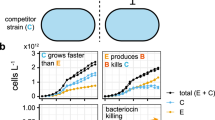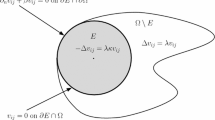Abstract
We develop a novel optimization framework to study strategies in ecological competition processes. The optimization method uses theory from dynamical systems describing the asymptotic behavior of a bistable system based on initial conditions, which we implement using a numerical boundary value problem. As an application of our method, we develop a model of the competition between Salmonella Typhimurium and the host’s native microflora, which constantly and densely inhabit the intestinal lining of most mammals. S. Typhimurium invades the gut in two distinct phenotypic populations, one virulent and one avirulent, though the avirulent bacteria have the ability to activate a virulence factor and thereby “switch” into the virulent population. Counterintuitively, some studies have found that the combined population of S. Typhimurium gains an environmental advantage over the commensal microbiota after the virulent subpopulation provokes the body’s inflammatory defenses. Our model represents the competition between the commensal microbiota, the avirulent salmonella, and the virulent salmonella populations and incorporates a simple representation of the immune response. We use our model to predict optimal strategies that would favor salmonella in its competition with the commensal bacteria.








Similar content being viewed by others
References
Arciero J, Ermentrout GB, Upperman JS, Vodovotz Y, Rubin JE (2010) Using a mathematical model to analyze the role of probiotics and inflammation in necrotizing enterocolitis. PLoS One 5(4):e10066
Brennan M, Cookson B (2000) Salmonella induces macrophage death by caspase-1-dependent necrosis. Mol Microbiol 38:31–40
Brown S, Chat LL, Taddei F (2008) Evolution of virulence: triggering host inflammation allows invading pathogens to exclude competitors. Ecol Lett 11:44–51
Day J, Rubin J, Vodovotz Y, Chow CC, Reynolds A, Clermont G (2006) A reduced mathematical model of the acute inflammatory response II. Capturing scenarios of repeated endotoxin administration. J Theor Biol 242:237–256
Ermentrout GB (2002) Simulating, analyzing, and animating dynamical systems: a guide to XPPAUT for researchers and students, 1st edn. Society for Industrial and Applied Mathematics, Philadelphia
Fields P, Swanson R, Haidaris C, Heffron F (1986) Mutants of Salmonella typhimurium that cannot survive within the macrophage are avirulent. Proc Natl Acad Sci USA 83:5189–5193
Gog J, Murcia A, Osterman N, Restif O, McKinley T, Sheppard M, Achouri S, Wei B, Mastroeni P, Wood J, Maskell D, Cicuta P, Bryant C (2012) Dynamics of Salmonella infection of macrophages at the single cell level. J R Soc Interface 9:2696–2707
Reynolds A, Rubin J, Clermont G, Day J, Vodovatz Y, Ermentrout GB (2006) A reduced mathematical model of the acute inflammatory response: I. Derivation of model and analysis of anti-inflammation. J Theor Biol 242:220–236
Santos R, Raffatellu M, Bevins CL, Adams LG, Tükel Ç, Tsolis RM, Bäumler AJ (2009) Life in the inflamed intestine, Salmonella style. Trends Microbiol 17:498–506
Stecher B, Robbiani R, Walker AW, Westendorf AM, Barthel M, Kremer M, Chaffron S, Macpherson AJ, Buer J, Parkhill J, Dougan G, von Mering C, Hardt W (2007) Salmonella enterica Serovar Typhimurium exploits inflammation to compete with the intestinal microbiota. PLoS Biol 5:2177–2189
Stecher B, Hardt W (2008) The role of microbiota in infectious disease. Trends Microbiol 16:107–114
Sturm A, Heinemann M, Arnoldini M, Benecke A, Ackermann M, Benz M, Dormann J, Hardt W (2011) The cost of virulence: retarded growth of Salmonella Typhimurium cells expressing type III secretion system 1. PLoS Pathog 7(7):e1002143
The Centers for Disease Control and Prevention, Salmonella, http://www.cdc.gov/salmonella/general/. Accessed 5 Mar (2014)
Thiennimitr P, Winter S, Winter M, Xavier M, Tolstikov V, Huseby D, Sterzenbach T, Tsolis R, Roth J, Bäumler A (2011) Intestinal inflammation allows Salmonella to use ethanolamine to compete with the microbiota. PNAS 108:17480–17485
Author information
Authors and Affiliations
Corresponding author
Appendix
Appendix
To determine the minimal initial salmonella population size necessary to outcompete the commensals, we rescale time by \(t=\tau s\) to transform system (4) to the following boundary value problem:
where \(^{\prime }=\frac{\hbox {d}}{\hbox {d}s}\), and
where \(\tau \) is a large positive number that we choose.
Here we consider \(d_r\) as a stationary variable instead of a parameter. Since we are minimizing \(S_0\), it might seem more natural to allow \(S_0\) to be a stationary variable and leave \(d_r\) as a parameter that we can vary. Solving such a boundary value problem and continuing the solution over varied \(d_r\) in AUTO results in solutions as in Fig. 9a, where the minimum value of \(S_{\mathrm{nec}}\) appears as a local minimum. Unfortunately, bifurcation continuation methods cannot continue along minima, as minima are not bifurcations. Treating \(d_r\) as a variable allows us to identify folds in the solution of the boundary value problem (7)–(8) where the derivative of \(d_r\) with respect to \(S_0\) becomes unbounded. Such a fold is shown in Fig. 9b. Solving the boundary value problem in this setting therefore allows us to continue the solution over a new parameter; in particular, we can continue the solution in x to determine \(S_{\mathrm{min}}=\min _{d_r} S_{\mathrm{nec}}(d_r,x)\).
Minimal salmonella population sizes necessary in successful invasions derived using boundary conditions (8). a The \(S_0\) value obtained by solving system (4) together with \(S_0^{\prime }=0\) and boundary conditions (8) over a range of \(d_r\) values. The bifurcation continuation software AUTO cannot continue along minima, and so this solution cannot be continued along a new parameter. b The \(d_r\) value obtained by solving system (7) with boundary conditions (8) for varied \(S_{\mathrm{nec}}\equiv S_0\). Here, the minimum value of \(S_{\mathrm{nec}}\) with respect to \(d_r\) is given by a fold bifurcation, which allows us to continue to track the minimum as x is varied in AUTO (Color figure online)
We seek the critical value of \(S_0\) so that beginning with any initial salmonella population size below this value results in the commensals outcompeting the salmonella, while initial salmonella population sizes above this level yield successful invasion. Our method to determine this value is based on the description in Sect. 2. After rescaling time, solutions to the boundary value problem (7)–(8) for fixed \(S_0\) and x return a value of \(d_r\) for which we have \(C(1)=U(1)+V(1)\), where C, U, and V are now considered functions of rescaled time s. Consequently, we are really searching for the value of \(d_r\) for which \(S_0=S_{\mathrm{nec}}(d_r,x)\). If \(S_0\) is any larger for the fixed x and \(d_r\), then \(U(s_0)+V(s_0)=C(s_0)\) for some \(0\le s_0< 1\), and if \(S_0\) is any smaller, then the combined population \(U+V\) will not match C before \(s=1\), and possibly never will. Analogous to the treatment of system (2) in Sect. 2, we can approximate the critical value of \(S_0\) within arbitrary precision by taking \(\tau \) sufficiently large. We take \(\tau =20\), which seems to be large enough to provide an accurate approximation of the critical \(S_0\), as seen in Fig. 10.
Similarly, in order to minimize \(S_{\mathrm{nec}}(d_r,x)\) over x for fixed \(d_r\), we consider the following system:
The technique to solve the boundary value problem (9) with boundary conditions (8) is identical to that described above, with the roles of \(d_r\) and x switched.
To add the constraint that the final proportion of avirulent salmonella is equal to the initial proportion of avirulent salmonella (or any fraction \(\beta \) of the initial proportion, although we set \(\beta =1\) here), we restrict our \((d_r,x)\) parameter values to only those such that \(x=U^*/(U^*+V^*)\), where \((U,V,C,M)=(U^*,V^*,0,M^*)\), \(U^*,V^*>0\) is the steady state corresponding to a successful invasion. We find such parameter pairs by continuing this steady state along \(d_r\) and setting \(x=U^*/(U^*+V^*)=U^*(d_r)/(U^*(d_r)+V^*(d_r))\) for each fixed \(d_r\). Since we do not have an analytical form for this steady state, we load the \(d_r\) and corresponding \(x=U^*/(U^*+V^*)\) values into XPPAUT as functions of a new parameter q, so that \((d_r(q),x(q))\) preserves the equality \(x_{\mathrm{init}}=x_{\mathrm{final}}\) for all q. We then solve the system
with boundary conditions (8) in XPPAUT. Here there is no advantage to treating x or \(d_r\) as a stationary parameter in place of \(S_0\), as our parameter space \((d_r,x)=(d_r,x(d_r))\) is now one dimensional, and consequently, we need only vary a single parameter to find the global minimum \(S_{\mathrm{min}}\). We continue the solution of the boundary value problem in AUTO over varied q, from which we can extract the corresponding \(d_r(q)\) and x(q) for each q, and the result is plotted in Fig. 8a, b.
Rights and permissions
About this article
Cite this article
Young, G., Ermentrout, B. & Rubin, J.E. A Boundary Value Approach to Optimization with an Application to Salmonella Competition. Bull Math Biol 77, 1327–1348 (2015). https://doi.org/10.1007/s11538-015-0087-3
Received:
Accepted:
Published:
Issue Date:
DOI: https://doi.org/10.1007/s11538-015-0087-3






